Having already bored you with our uneventful trip I will spare you the details of what we ate for supper except to note that the Carlisle is an Amish business and many of the people who work there are Amish. The Amish are a plain, sturdy, wholesome, rather-sweet people and they serve plain, sturdy, wholesome, rather-sweet food about which I will say nothing -- except that "Noodles on Mashed Potatoes" seems an odd main dish and that the next time I go there I must try it, if only to hear Dr. Atkins whirling in his grave.
In the morning, after a tasty, if oxymoronic, sturdy Amish contenential breakfast at the hotel, we were off to the Warther's Carving Museum and Knife Factory in nearby Dover. The Warther Museum is a wonderful place and well worth visiting if you are ever in Ohio (or in Maryland, Pennsylvania, West Virginia, D.C., etc. etc. etc..) As a matter of fact, if you have never been there you should drop whatever you are doing, buy a ticket to Cleveland, rent a car and head for Dover right now. Be sure to bookmark this page so you can finish reading when you get back.
Ok, I'm kidding... mostly. But I do think that Warther's is pretty darn cool. Part of this may be because I remember it from when I was a kid. I remember meeting Mooney Warther, who did all the carvings in the museum.
 (He looked a lot like this when I met him, not long before his death.) He would sit in a rocking chair in the lobby of the museum and carve a pair of working pliers out of a piece of soft wood with ten quick cuts. Even at his advanced age it took about fifteen seconds. Pretty cool when you are a kid. I also remember his carvings (which impress me more as a grown-up than they did then.) But, mostly, I remember the swing.
(He looked a lot like this when I met him, not long before his death.) He would sit in a rocking chair in the lobby of the museum and carve a pair of working pliers out of a piece of soft wood with ten quick cuts. Even at his advanced age it took about fifteen seconds. Pretty cool when you are a kid. I also remember his carvings (which impress me more as a grown-up than they did then.) But, mostly, I remember the swing. 
Mooney Warther had made the swing for his own children and grandchildren but he let tourist children use it, too. It hung from a high branch of a huge Elm tree, suspended by ninty feet of rope (or steel cables?) The arc of the swing followed the hillside up the hill so you could get in at the bottom of the arc and walk yourself up the hill. Then when you picked up your feet you would swing back down the way you came up and then out over the drop-off. I don't know how high you were at the far end of the arc. As a kid it seemed like you were half a mile off the ground but it was probably about 40 feet. It was like flying.
The tree died in the mid seventies from Dutch Elm Disease and the swing is long gone. Its like will not be seen again. It was a part of a different world -- a world where children were protected by the Grace of God, not by Loads of Lawyers. If the tree hadn't been taken out by Dutch Elm Disease, Mooney Warther's insurance company would have called in an air strike before someone fell off and sued them.
The grounds of the museum (the backyard of the old family house) are still pretty neat. They have the nicely restored Dover, Ohio depot and a railroad caboose at the bottom of the hill. The depot is more or less under the path of the old swing. To get a sense of the swing from this photo, imagine a kid's foot dangling into the frame at the upper left corner.
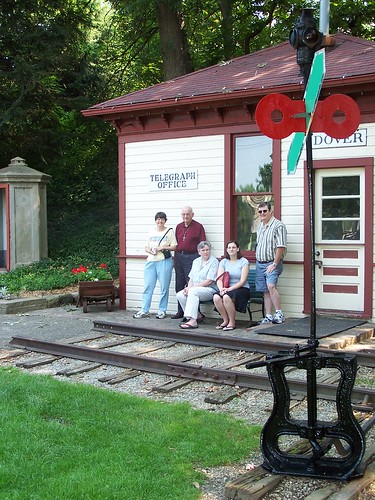
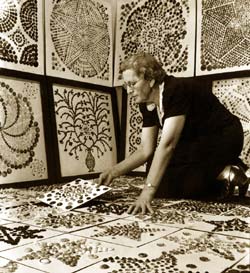 There is also a building dedicated to Freida Warther's button collection. (Freida was Mooney's wife.) Some of my relatives were friends of the Warthers and they were always on the lookout for interesting or unusual buttons for her collection. The button collection is pretty much as shown in this photo -- all four walls covered floor to panels with buttons sewn on and the ceiling is covered with buttons, too. The buttons on the floor are gone, though, as is Mrs. Warther who passed away several years ago after working with her buttons and her garden well into her ninties.
There is also a building dedicated to Freida Warther's button collection. (Freida was Mooney's wife.) Some of my relatives were friends of the Warthers and they were always on the lookout for interesting or unusual buttons for her collection. The button collection is pretty much as shown in this photo -- all four walls covered floor to panels with buttons sewn on and the ceiling is covered with buttons, too. The buttons on the floor are gone, though, as is Mrs. Warther who passed away several years ago after working with her buttons and her garden well into her ninties.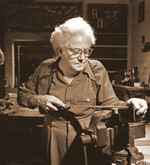 But back to the museum. Ernest "Mooney" Warther was an amazing man. His family business was (still is) making kitchen knives and his hobby was wood carving. Although he was not Amish himself he lived in Amish country in Ohio and he took a lot of pride in the fact that he did his carving using only hand tools. He had an uncanny knack for carving perfectly circular or cylindrical objects without using a lathe. He didn't need machines to do that sort of thing and he didn't use them.
But back to the museum. Ernest "Mooney" Warther was an amazing man. His family business was (still is) making kitchen knives and his hobby was wood carving. Although he was not Amish himself he lived in Amish country in Ohio and he took a lot of pride in the fact that he did his carving using only hand tools. He had an uncanny knack for carving perfectly circular or cylindrical objects without using a lathe. He didn't need machines to do that sort of thing and he didn't use them. Given his pride in hand work and simple tools it may seem a bit odd that he decided, early in life that his life's work would be to carve The History of the Steam Locomotive in wood. He loved machinery with a passion -- he just didn't hold with using it in his carving. Here are a few photos I took of the trains he carved.
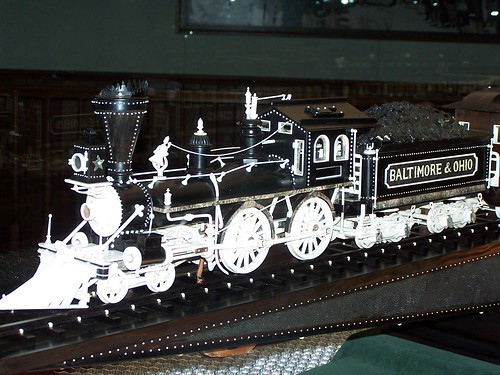
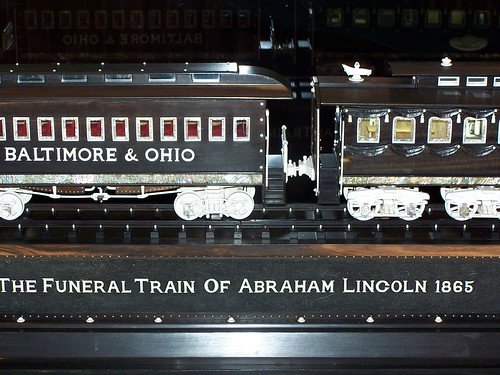
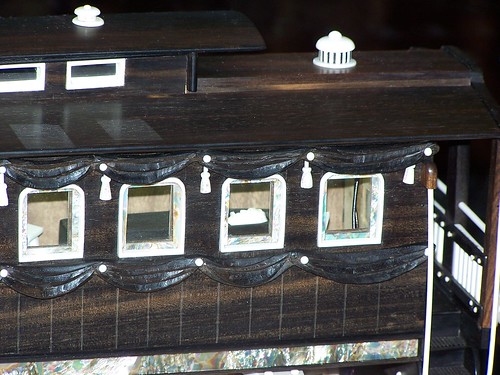
Still pictures don't do the carvings justice since the carvings aren't still. They are working replicas -- the wheels turn, the pistons move in and out, the doors open and close -- and some of them have been running without repair for almost ninety years. The models are driven by electrical motors that he stole from his wife's sewing machine whenever he finished a new train.
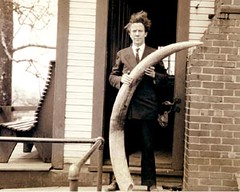 When he started carving he used bone instead of ivory for the white pieces and the inlay lettering. He would fish the bones out of the soup pot and throw them on the roof for the sun to bleach. Later, when he was more affluent, he was able to replace the bone parts with ivory and to switch for his new carvings from native woods to exotics such as ebony.
When he started carving he used bone instead of ivory for the white pieces and the inlay lettering. He would fish the bones out of the soup pot and throw them on the roof for the sun to bleach. Later, when he was more affluent, he was able to replace the bone parts with ivory and to switch for his new carvings from native woods to exotics such as ebony.By 1923 his carvings were so well known that the New York Central Railroad built a special car to exhibit them and took them on a tour and Mooney Warther with them. The carvings were then exhibited for two years in Grand Central Station in New York and Mooney and his family lived in the city while they were there. After two years he decided to move himself and his carvings back to Ohio. The railroad offered him a huge amount of money to stay in New York (over a million dollars in today's money) but Mooney told them that he and his wife had talked it over and that it was clear to them that God had not intended for anyone to stay in the city of New York for more than ten days at a time and he turned them down.
 The Warther family has been making kitchen knives since 1902 when this photo was taken of their workshop. They still make knives today and it is still largely a family business in the third and fourth generation. Several Mooney's great-grandchilren work in the shop making knives and in the gift shop where visitors can buy them. A set of Warther's knives is an obligatory wedding gift in my family. I have used mine almost every day for almost thirty years.
The Warther family has been making kitchen knives since 1902 when this photo was taken of their workshop. They still make knives today and it is still largely a family business in the third and fourth generation. Several Mooney's great-grandchilren work in the shop making knives and in the gift shop where visitors can buy them. A set of Warther's knives is an obligatory wedding gift in my family. I have used mine almost every day for almost thirty years. 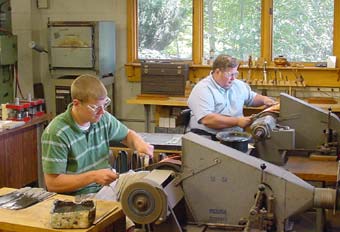
The thing that makes the Warther museum so inspiring isn't that Mooney Warther had superhuman talent or that he was a genius. He was talented, that is clear, but his talents were entirely human in scale and his genius, if you want to call it that, was in deciding what things were going to be important to him in his life and setting about getting them done in an amazingly purposeful and efficient way.

6 comments:
What a great write up, Lee! I loved this story and its photos!
Joel Haas, sculptor
What a cool story. It reminds me of the many incredibly talented older folks that I knew as a kid. They were so humble and giving of their time.
....we just got back from vacation and visited the warther museum in dover. it is one of the most incredible places that i have ever seen, and undoubtedly mooney warther was a mechanical, mathematical genius. great site; i am not a math person, nor an engineer, history is my passion, but whomever you are, please go check this place out, you will truly be amazed at the talent of this man.
My wife and I visited the Warther Museum a few years ago and I immediately decided that I wanted to find the time to take my parents to see this remarkable place. I was finally able to do so last week and my 83 & 82 year-old parents were amazed with "Mooney" Warther's work. My Mom, who had to quit high school in the 10th grade to help support her family during the Depression, was in tears just realizing what this man with only two years of "formal" education could do. This museum is a "must see."
I just got back from there, today!!! And I must say you did a great job of describing the indescribable.
The man, his work and the museum simply have to be seen to be belived (loved the story about when Ripley of 'Ripley's Believe It Or Not' fame met Warther at the Worlds Fair).
I can't belive I spent most of my life in Ohio yet it took me over 40years to discover this treasure in my own backyard.
Just go see it!
BigLeeH,
I grew up in Dover and first met Mooney when I was 4, he was 81. That day he carved pliers for me and my friend Dale, and we swang on THE swing. That was before Dover/Newphilly even had any fast food restaurants. We walked home from school (2.5 miles) if we were first grade or above.
Post a Comment